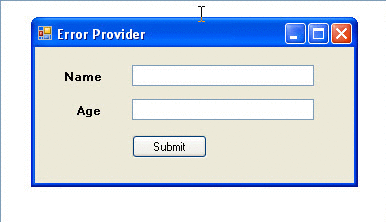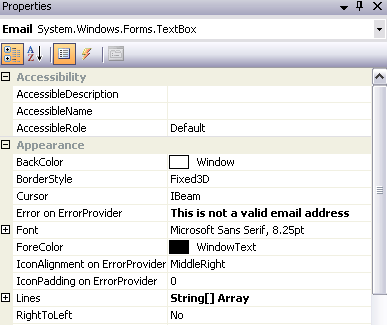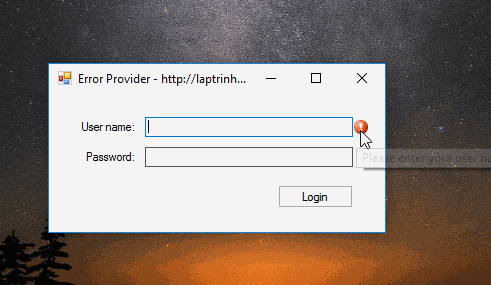

- #VB.NET USING ERRORPROVIDER IN LEAVE EVENT FULL#
- #VB.NET USING ERRORPROVIDER IN LEAVE EVENT CODE#
- #VB.NET USING ERRORPROVIDER IN LEAVE EVENT WINDOWS#
The build process makes your business object accessible to the Data Sources window.
#VB.NET USING ERRORPROVIDER IN LEAVE EVENT CODE#
For more information on using snippets or creating your own, see the article “Having Fun with Code Snippets” in the Jan/Feb 2006 issue of CoDe Magazine.Īfter you have defined any desired properties on your business object, build the project. In a C# code window, type prop and then press tab twice to create a property. In a VB code window, type property and then press tab to create a VB Property procedure. The quickest way to create property procedures is to use the property snippet.



The LastName property code is as follows. For example, a Customer class has LastName, FirstName, and CustomerID properties.
#VB.NET USING ERRORPROVIDER IN LEAVE EVENT WINDOWS#
This sample adds all of the classes to the Windows Forms project for simplicity.) Then give that class several properties. (In a “real” application, you’d likely put the class into a separate project. To try out object binding, create a new Windows Forms project and add a class to the project. That gives you much more control and greatly simplifies the maintenance of your application. Unlike binding to a database, which generates a significant amount of code and then binds to that generated code, object binding binds to your code. Rather, all of this is handled automatically. And then visa versa when the user changes the text in the controls. With object binding, you don’t have to write code to put the value of the Last Name property into the Text property of the Last Name TextBox and the First Name property value into the Text property of the First Name TextBox. And when the user modifies the contents of the controls, the updated values are automatically assigned to the properties of your business object.įor example, suppose you have a form that displays customer information and a Customer business object with Last Name and First Name properties. When you create a business object and assign values to the properties, the user interface of your application will reflect those values without you needing to write code to copy property values into the controls. The basic premise of object binding in Windows Forms is to tie Windows Forms control properties, such as the Text property, to your business object properties. Once you see all of the things that object binding can do, you may find a new love as well. It then presents tips and tricks for enhancing your object binding. This article first reviews some object binding fundamentals. But I have to admit, I love object binding.Īny time you add a property to the business object, you must rebuild the project before the property will appear in the Data Sources window. It incorporated patterns that were not extensible, it did not make use of good programming practices, and it frequently didn’t work as expected. I was one of those many developers who, since Visual Basic 2.0, have hated the concept of data binding. In this article I’ll present a few tricks you need to know to get the most from your object binding.
#VB.NET USING ERRORPROVIDER IN LEAVE EVENT FULL#
Gaining the full potential of object binding requires more than just dragging and dropping your properties onto forms.


 0 kommentar(er)
0 kommentar(er)
